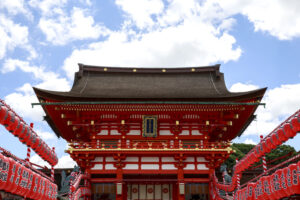Number Of Followers Of Shintoism
Japanese religions and percentages
Religions in Nihon in 2022
Are there any surveys on religions in Japan for 2022?
Co-ordinate to the results of a 2018 poll on religions in Japan, a total of 36% of respondents said they follow some class of religion, including 31% who said Buddhism and 3% who said Shinto. Of those who responded that they follow some kind of religion, 53% answered "yes" to the question of whether or non they accept religious behavior.
The percentages of religions in Nihon according to this latest survey are every bit follows:
Buddhism 31%
Shinto 3%
Christianity 1%
Other 1%
No answer 2%
No religious beliefs 62%
Other survey results on religious demographics of Japan
According to the 2022 edition of the Organized religion Yearbook past the Agency for Cultural Affairs in Nippon, the number of believers in each religion was 87,924,087 (48.5%) for Shinto, 83,971,139 (46.3%) for Buddhism, 1,909,757 (1.0%) for Christianity, and 7,403,560 (4.0%) for other various religions (those other than Shinto, Buddhism, and Christianity ).
This is about 1.5 times the full population of Japan (almost 126 meg)
There are certainly people who are counted as "believers" of more than one faith.
Factors contributing to these figures:
Because statistical surveys are conducted on a declarative basis with religious organizations as respondents, religious organizations tend to report a larger number of followers for their own organizations.
Christianity and Islam make a articulate distinction between believers and non-believers, even if they attend services regularly; they are not treated as believers until they undergo an initiation ceremony such every bit baptism or shahada. Too, in many Christian organizations, if a person is no longer heard from, he or she is excluded after a few years. In Shintoism and Japanese Buddhism, yet, initiation ceremonies and audio communication are not taken into consideration, and all family members who are members of a shrine'southward community or reverence association are considered believers.
In Buddhism, fifty-fifty those who get followers of other religions or declare no religious affiliation are counted as parishioners of the temple to which the family of birth belongs. Besides those who visit shrines and temples for the first time are said to exist included in the number of believers in some cases.
In today's Japanese society, an individual'south religious affiliation is generally not considered very important, and individuals are not very conscious of their own religious beliefs. Therefore, there are protests against the survey methods described above.
According to the Religion Yearbook, Shintoism has about the same number of followers as Buddhism, just considerably fewer people consider themselves "believers" in Shintoism than in Buddhism.
For these reasons, the demographics of religions in Japan in the Religion Yearbook is not realistic.
Shintoism-Buddhism syncretism
The era of Shintoism-Buddhism syncretism (a form of syncretism) lasted for a long time in Japan. Even after the Meiji Restoration, when Shintoism and Buddhism were separated, the distinction between Shintoism and Buddhism remained ambiguous. Many households enshrine a kamidana (Shinto altar) and have a Buddhist altar, and many households are both parishioners of a Buddhist temple and clergymen of a Shinto shrine. This is why the total number of Shintoists and Buddhists is said to exceed 200 million.
Historically, and even today, the Shinto religion is associated with ceremonial events such as weddings, traditional celebrations, and praying for luck, while the Buddhist religion is associated with funeral rites, memorial services, and other events related to the concept of death or subsequently-expiry.
Although the majority of Japanese citizens today participate in such so-called religious rituals, they take little sense of belonging to any particular religious system, and many consider themselves to be non-religious. In this example, "no organized religion" differs from atheism, which denies the being of God or Buddha; "no organized religion" ways that although the individual believes in something to some extent, they exercise not recognize it equally "religion," nor do they wholeheartedly belong to any particular religious organisation or doctrine.

New Age Religions in Japan
The per centum of new age religions is estimated to be around ane percent.
A religious organization, "Happy Science," says that it has over eleven one thousand thousand believers. However, that is co-ordinate to the organization itself. The actual number is said to be 200,000 to 300,000.
SGI (Soka Gakkai International) says that it has believers in 8,270,000 households . Nonetheless, this number is not realistic, every bit it would mean that virtually 16 percent of the Japanese population are believers in Soka Gakkai. Soka Gakkai is the primary supporter of one of Japan's major political parties, Komeito.
Number Of Followers Of Shintoism,
Source: https://www.jluggage.com/blog/japan/religions-in-japan/
Posted by: beckdiden1961.blogspot.com


0 Response to "Number Of Followers Of Shintoism"
Post a Comment